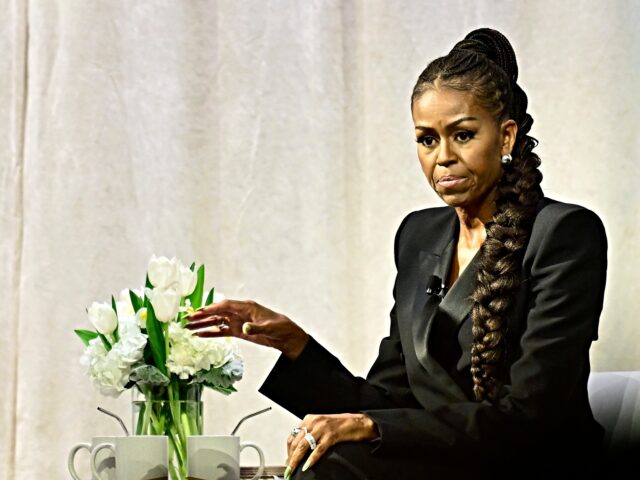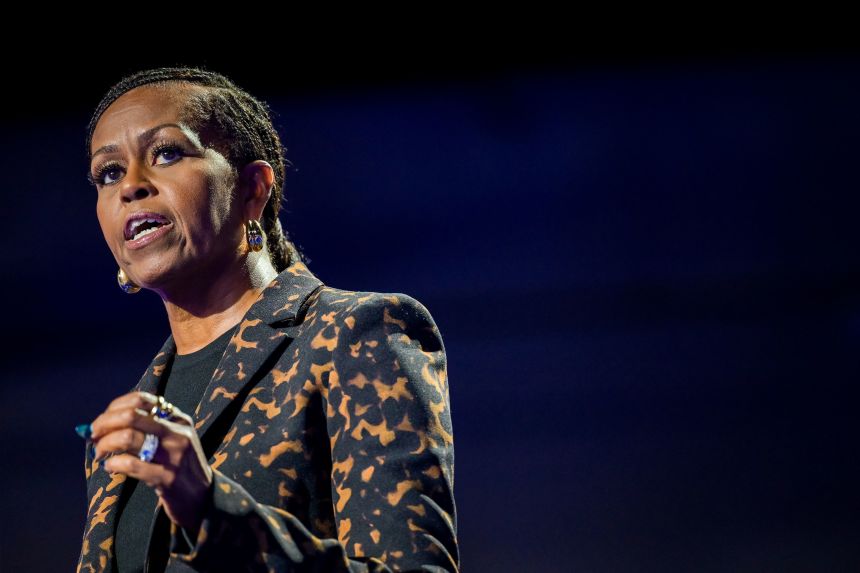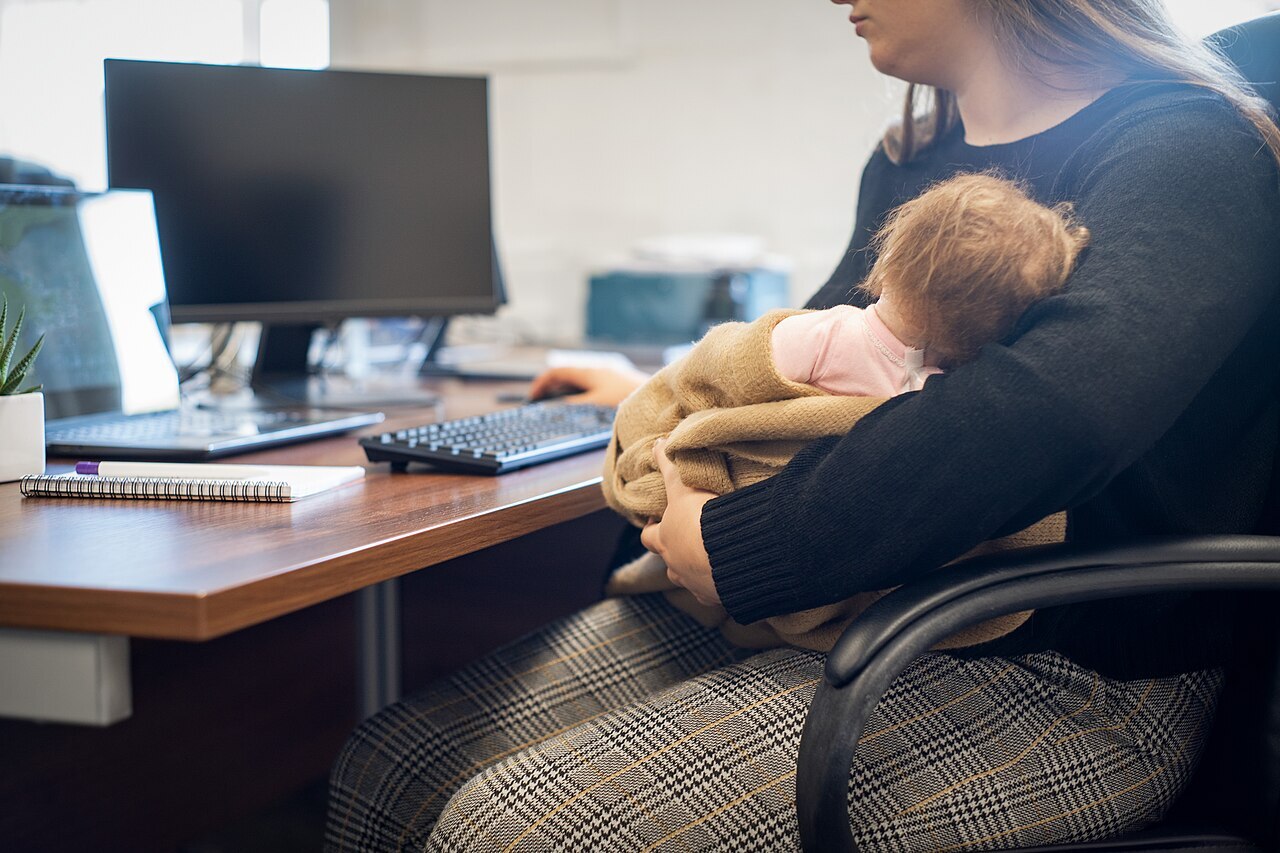

Michelle Obama not only said Friday she won’t be running for president because Americans “aren’t ready for a woman president,” she also implied they weren’t ready for her in the White House as a black First Lady.
Obama cited Kamala Harris’s loss to Donald Trump in 2024 as her evidence of the country’s sexism, saying Americans have “a lot of growing up to do.”
“As we saw in this past election, sadly, we ain’t ready,” she told an audience at Brooklyn Academy of Music while promoting her new book, The Look. “That’s why I’m like, don’t even look at me about running, because you all are lying. You’re not ready for a woman. You are not.”
“You know, we’ve got a lot of growing up to do,” she continued. “And there’s still, sadly, a lot of men who do not feel like they can be led by a woman, and we saw it.”
Obama appeared to amplify previous complaints on her book tour that she was under a “particularly white hot glare” as a black First Lady, saying even Democrats were trying to destroy her when she became “effective” when her husband was running in the primaries for the 2008 nomination.
She told the audience:
Let me be clear, these were our people who were going after me. This started when we were running against our party. The beginning of turning me into an angry shrew who diminished her husband, who didn’t love her country, who was unpatriotic…These people are lying. They’re making stuff up because they’re trying to win.
She said when she got to the White House she had to “quickly define myself” and “I didn’t even feel I had the support of the campaign” because “they were white folks, too.”
“So, I knew this immediately. And I knew this coming in as First Lady, that I was in charge of my story, my narrative,” she said. “I had to be smarter than them. I had to outsmart everyone and that came to everything I did, including what I wore.”
Obama’s book, released earlier this month, explores her experience with fashion and beauty while also claiming that women in politics are often judged based on their physical appearance instead of leadership qualities.
While the former First Lady claims she faced heavy criticism during her time in the White House, she was often celebrated in the legacy media and appeared on the cover of Vogue three times.
As Breitbart News reported, apparently lost on Obama is the experience of current first lady Melania Trump. A former super model, she has been snubbed by the establishment media and leftist magazines, despite her status as a high fashion figure throughout her life.
Michelle Obama says the country is ‘not ready for a woman’ president

Former first lady Michelle Obama said at a recent event that the US isn’t ready for a woman president, pointing to former Vice President Kamala Harris’ unsuccessful bid for the White House last year.
“As we saw in this past election, sadly, we ain’t ready,” Obama said in response to a question from actor Tracee Ellis Ross on whether there has been enough “room” created for a woman president.
“That’s why I’m like, don’t even look at me about running ‘cause you all are lying. You’re not ready for a woman,” Obama told Ellis Ross. “We got a lot of growing up to do and there’s still … a lot of men who do not feel like they can be led by a woman and we saw it.”
Obama’s conversation with Ellis Ross took place in Brooklyn, New York, to promote her new book, “The Look,” which is about her approach to fashion and politics during her and former President Barack Obama’s time in the White House. The conversation was posted onlineon Friday.

The former first lady is among Democrats’ most effective — and popular — surrogates, which for years, has fueled a desire among her supporters that she run for president. Michelle Obama has repeatedly shut down that speculation.
“I will not run for president. No, nope, not going to do it,” she said in 2016 while still serving as first lady.
Obama campaigned for Harris last year, raising alarm about what she described as the threat Trump poses to the country, particularly to women’s health.
“Please, please do not hand our fates over to the likes of Trump, who knows nothing about us, who has shown deep contempt for us,” Obama said at a Michigan rally days before the election. “Because a vote for him is a vote against us, against our health, against our worth.”
At the same rally, Obama asked the crowd: “By every measure, (Harris) has demonstrated that she’s ready. … The real question is, as a country, are we ready for this moment?”

Another ‘she-cession’ is rearing its head: Women are leaving the workforce at alarming rates
EDITOR’S NOTE: Filmed over seven years, Prime Minister is an unflinching look at Jacinda Ardern’s extraordinary political career, tracing her unexpected ascent to leadership in 2017, when at 37 she became one of the youngest heads of state in the world and the second ever to give birth while in office. As Ardern steps away from public life, Prime Minister provides a powerful reflection on leadership, motherhood, and the demands of governing in an age of misinformation and division.
CNN Films will premiere Prime Minister on Sunday, November 16 at 9pm ET/PT on CNN. It will be available to stream the next day for subscribers of CNN’s All Access streaming offering.
There’s a chilling trend emerging in the job market: Women are dropping out of the US labor force at some of the highest levels in history.
An estimated 455,000 women left the workforce between January and August this year, a period when the overall labor force has held relatively steady, Bureau of Labor Statistics data shows.

Only the pandemic saw a larger exodus for that period, according to BLS records that go back to 1948.
Economists are sounding the alarm: The losses, if continued, not only stand to erase the historic gains made by women in recent years but also risk stifling US economic growth.
“It’s diminishing both current and potential growth in the economy,” said Diane Swonk, chief economist at KPMG. “You want an economy that has as many people who want to have their hat in the ring working and their talents as possible. It’s not a zero-sum game. It’s not men or women. We need everybody. We need all hands on deck.”
Reversing trends
In the years leading up to the pandemic, the labor force participation rate for prime working-aged women (25-54 years old) rose faster than that of their male counterparts.
There were some key reasons behind that shift: Fast-growing industries such as health care and caregiving were predominantly female; educational attainment for women rose substantially; and women made greater inroads into traditionally male-dominated fields such as construction, agriculture, and repair and maintenance.
Then came the pandemic, which put 21.9 million people out of work, 55% of whom were female. The participation rate for prime working-aged women plunged by more than 3 percentage points to 73.5% in just one month. (Labor force participation rates typically move very modestly, nudging up or down by just tenths of a percentage point over the span of years.)
But as the economy recovered in the following months, the rebound was sluggish for women — so much so that the period was dubbed a “she-cession” as female workers suffered higher rates of unemployment and worse employment outcomes than men.

The pandemic battered female-dominated industries; rising costs and worker shortages in the child care sector hampered moms’ abilities to return to work; and women, who usually take on caregiving responsibilities, stayed home to tend to aging parents and relatives.
“Post-pandemic, we finally saw women come back en masse, and part of that was due to hybrid and work-from-home (arrangements), and it enabled women to work in ways where they could rejoin the labor force,” Swonk said.
Women’s prime-age participation rate hit an all-time high last year of 78.4%. However, in recent months, participation has been hovering at around 77.7%.
“We had finally, after decades, gotten past the peak that we hit in 2000. It took a hiring frenzy and hybrid work to get us back up again and exceed that level, which is stunning and a bit of a sad commentary, because we lag other major developed economies,” Swonk said.

Highly educated mothers, Black women leading the exodus
The factors behind the falloff are multifaceted and several are systemic in nature.
There’s the biggie: Child care and early education costs continue to rise. Some operators within that industry are in “grim, financial binds,” University of California-Berkeley researchers have found. Low funding and poor pay has contributed to worker shortages (now further exacerbated by immigration reductions) as well as “child care deserts.” The cost burden is pushed instead to families, who often find the prospects too pricey.
“Women with children under five are driving the outflow from the labor force; and that’s important, because what we’re seeing is women with a [bachelor’s degree] or higher and with children under five are leaving at more than twice the pace of anyone else,” Swonk said. “A lot of very highly skilled, highly trained, highly educated workers are now just leaving the labor force entirely.”
The disruptions due to a lack of child care come at a significant financial cost to businesses, she added.
Also, when women take breaks from the workforce, not only are their lifetime earnings disrupted, but the negative financial impacts can be generational, she said.
“Historically, when women are providers for their family, their children do better off, too; so, what we worry about is the long-term scarring due to the loss of resources for their children,” she said.

Elsewhere, return-to-office mandates have stripped away flexible working arrangements for some employees. The rise of AI coupled with a slow-churn, anemic labor market has put the squeeze on white-collar and customer-facing industries.
The second-largest cohort leaving the labor force is Black women, Swonk said.
“When the economy gets weaker, you tend to see marginalized groups get hit harder,” she said. “The slowdown in demand and supply in workers is happening in tandem, but it’s harder for groups that don’t have a cushion of wealth or the same means as other groups.”
And then there’s been the federal-level policy shifts: President Donald Trump has taken actions such as slashing the ranks of the US public sector (where women, particularly Black women, are heavily employed) and rolling back equal opportunity and diversity, equity and inclusion-related efforts.
“The attack on public sector employment by the administration is playing out with regard to where women are positioned in the workforce,” said Michelle Holder, associate professor of economics at John Jay College at City University in New York. “There also have been policy proposals by the administration either overtly, or not so subtly, encouraging women to leave the labor force and concentrate on home and hearth.”

The White House, in response to a CNN query, highlighted recent efforts to support women such as creating investment accounts for newborns and increasing the Child Tax Credit, the Employer-Provided Child Care Credit, and the Dependent Care Assistance Plan.
“President Trump has a proven record of building an economy that benefits all Americans, including women, and he is implementing the same economic agenda that produced historically low unemployment rates in his first term,” Taylor Rogers, a White House spokeswoman, wrote in an emailed statement. “President Trump is fostering a dynamic economy that creates opportunities for all Americans, including his Working Families Tax Cuts bill that is unleashing economic growth, lowering costs, providing flexibility for families, and promoting generational success.”
Why women left
For women who left the labor force this year, their experiences are heavily nuanced, CNN’s interviews with more than two dozen women show.
Some decisions came easy: Workplaces became discriminatory, toxic, inflexible, sexist, or ageist; or life, health or family proved far more important.
A female executive with two young children eventually burnt out after juggling home life and her C-suite responsibilities.
A former Army JAG and longtime federal lawyer ultimately couldn’t pass up the US government’s second “fork in the road” offer because her ailing father’s condition worsened.
Other decisions were not easy: The dream jobs landed after years of climbing the ladder abruptly disappeared because of broader macroeconomic matters, loss of funding or an unexpected family development.
A first-time mother left the job she loved because the cost for three-day-a-week child care surpassed that of the monthly mortgage.

“I put everything I had into that job; I gave them everything, and I feel like I’m the most experienced and the most competent that I have ever been,” said Katharine Ransom-DiCerbo, 35, who left her role at a nonprofit organization earlier this year. “But my mental and my physical health broke down to the point where I could not go back.”
“Maybe we have been put in positions where the demands of work have become so large that we are not able to take care of ourselves, our families or grow our families,” she added.
.









:max_bytes(150000):strip_icc():focal(741x276:743x278)/George-Santos-Donald-Trump-101725-b8e7ac205d3b47eda1f4a8a0803ee051.jpg?w=1200&resize=1200,0&ssl=1)


























:max_bytes(150000):strip_icc():focal(999x0:1001x2)/no-time-to-die-1-2000-0892ec328cf04d98abd4c7cf18483821.jpg?w=1200&resize=1200,0&ssl=1)




:max_bytes(150000):strip_icc():focal(736x275:738x277):format(webp)/sydney-towle-120525-2-a3f5696600514167b3e038d003990333.jpg?w=1200&resize=1200,0&ssl=1)



